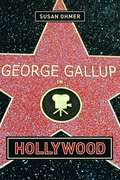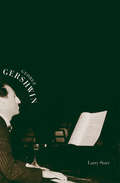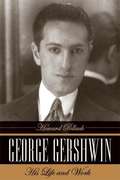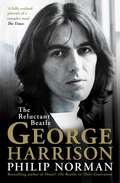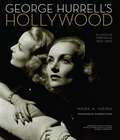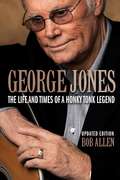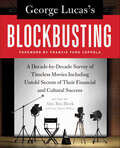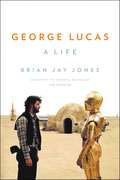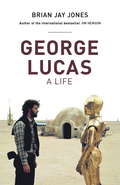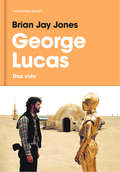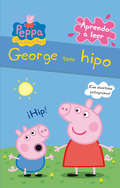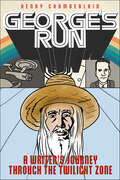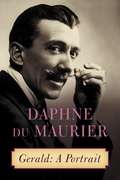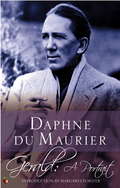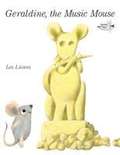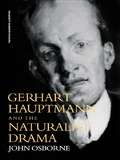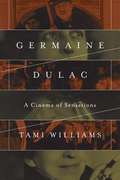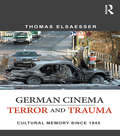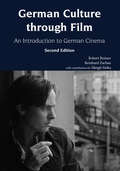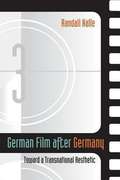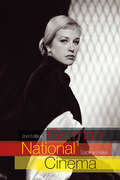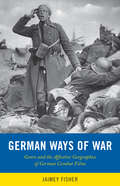- Table View
- List View
George Gallup in Hollywood
by Susan OhmerA fascinating look at the film industry's use of opinion polling in the 1930s and '40s.
George Gallup in Hollywood (Film and Culture Series)
by Susan OhmerGeorge Gallup in Hollywood is a fascinating look at the film industry's use of opinion polling in the 1930s and '40s. George Gallup's polling techniques first achieved fame when he accurately predicted that Franklin D. Roosevelt would be reelected president in 1936. Gallup had devised an extremely effective sampling method that took households from all income brackets into account, and Hollywood studio executives quickly pounced on the value of Gallup's research. Soon he was gauging reactions to stars and scripts for RKO Pictures, David O. Selznick, and Walt Disney and taking the public's temperature on Orson Welles and Desi Arnaz, couples such as Fred Astaire and Ginger Rogers, and films like Gone with the Wind, Dumbo, and Fantasia. Through interviews and extensive research, Susan Ohmer traces Gallup's groundbreaking intellectual and methodological developments, examining his comprehensive approach to market research from his early education in the advertising industry to his later work in Hollywood. The results of his opinion polls offer a fascinating glimpse at the class and gender differences of the time as well as popular sentiment toward social and political issues.
George Gershwin
by Larry StarrIn this welcome addition to the immensely popular Yale Broadway Masters series, Larry Starr focuses fresh attention on George Gershwin's Broadway contributions and examines their centrality to the composer's entire career. Starr presents Gershwin as a composer with a unified musical vision--a vision developed on Broadway and used as a source of strength in his well-known concert music. In turn, Gershwin's concert-hall experience enriched and strengthened his musicals, leading eventually to his great "Broadway opera,"Porgy and Bess. Through the prism of three major shows--Lady Be Good(1924),Of Thee I Sing(1931), andPorgy and Bess(1935)--Starr highlights Gershwin's distinctive contributions to the evolution of the Broadway musical. In addition, the author considers Gershwin's musical language, his compositions for the concert hall, and his movie scores for Hollywood in the light of his Broadway experience.
George Gershwin: His Life and Work
by Howard PollackThis comprehensive biography of George Gershwin (1898-1937) unravels the myths surrounding one of America's most celebrated composers and establishes the enduring value of his music. Pollack's lively narrative describes Gershwin's family, childhood, and education; his early career as a pianist; his friendships and romantic life; his relation to various musical trends; his writings on music; his working methods; and his tragic death at the age of 38.
George Harrison: The Reluctant Beatle
by Philip NormanFrom the author of the million-copy selling Shout!: The Beatles in Their Generation and the bestselling John Lennon: The Life comes a revealing portrait of George Harrison, the most undervalued and mysterious Beatle. Despite being hailed as one of the best guitarists of his era, George Harrison, particularly in his early decades, battled feelings of inferiority. He was often the butt of jokes from his bandmates owing to his lower-class background and, typically, was allowed to contribute only one or two songs per Beatles album out of the dozens he wrote. Now, acclaimed Beatles biographer Philip Norman examines Harrison through the lens of his numerous self-contradictions. Compared to songwriting luminaries John Lennon and Paul McCartney he was considered a minor talent, yet he composed such masterpieces as &‘While My Guitar Gently Weeps&’ and &‘Here Comes the Sun&’, and his solo debut album &‘All Things Must Pass&’ achieved enormous success, appearing on many lists of the 100 best rock albums ever. Modern music critics place him in the pantheon of Sixties guitar gods alongside Eric Clapton, Jimi Hendrix, Keith Richards and Jimmy Page. Harrison railed against the material world yet wrote the first pop song complaining about income tax. He spent years lovingly restoring his Friar Park estate as a spiritual journey, but quickly mortgaged the property to help rescue a film project that would be widely banned as sacrilegious, Monty Python&’s Life of Brian. Harrison could be fiercely jealous, but not only did he stay friends with Eric Clapton when Clapton fell in love with Harrison's wife, Pattie Boyd, the two men grew even closer after Clapton walked away with her.Unprecedented in scope and filled with numerous colour photos, this rich biography captures George Harrison at his most multi-faceted: devoted friend, loyal son, master guitar-player, brilliant songwriter, cocaine addict, serial philanderer, global philanthropist, student of Indian mysticism, self-deprecating comedian and, ultimately, iconic artist and man beloved by millions.
George Hurrell's Hollywood: Glamour Portraits 1925-1992
by Mark A. Vieira Sharon StoneFabulous montage of new insights, new portraits, and behind-the-scenes stories spanning Hurrell's entire career.
George Jones: The Life and Times of a Honky Tonk Legend
by Bob AllenGeorge Jones's nearly 60-year recording and performing career has had a profound influence on modern country music and influenced a younger generation of singers, including Garth Brooks, Alan Jackson, Randy Travis, Tim McGraw, and Trace Adkins. As Merle Haggard said of Jones in Rolling Stone magazine, “His voice was like a Stradivarius violin: one of the greatest instruments ever made.” Jones's saga is a larger-than-life tale of rags to riches and back to rags again. He was born into near poverty in a backwater patch of East Texas. His formal education ended early; by his early teens, he was singing on the streets of Beaumont, Texas, for tips. After beginning to record in the mid-1950s Jones became, by sheer dint of his vocal prowess, one of Nashville's most celebrated honky-tonk singers. But from the start, Jones's life, as often reflected in his music, was shaped by misdirection, chaos, turmoil, and emotional strife aggravated by a ferocious appetite for alcohol. Fame and adulation seemed to merely intensify his personal travails. Jones's story has a relatively happy ending. With the help of fourth wife Nancy during the final decade and a half of his life, he got clean and sober, was feted as a much-revered elder statesman for the music, and, by most accounts, found peace of mind at long last.
George Lucas's Blockbusting: A Decade-by-Decade Survey of Timeless Movies Including Untold Secrets of Their Financial and Cultural Success
by Lucy Autrey Wilson Alex Ben BlockA comprehensive look at 300 of the most financially and/or critically successful motion pictures of all time—many made despite seemingly insurmountable economic, cultural, and political challenges—set against the prevailing production, distribution, exhibition, marketing, and technology trends of each decade in movie business history.
George Lucas: A Life
by Brian Jay JonesThe essential biography of the influential and beloved filmmaker George LucasOn May 25, 1977, a problem-plagued, budget-straining independent science-fiction film opened in a mere thirty-two American movie theaters. Conceived, written, and directed by a little-known filmmaker named George Lucas, the movie originally called The Star Wars quickly drew blocks-long lines, bursting box-office records and ushering in a new way for movies to be made, marketed, and merchandised. It is now one of the most adored-and successful-movie franchises of all time.Now, the author of the bestselling biography Jim Henson delivers a long-awaited, revelatory look into the life and times of the man who created Luke Skywalker, Han Solo, and Indiana Jones. If Star Wars wasn't game-changing enough, Lucas went on to create another blockbuster series with Indiana Jones, and he completely transformed the world of special effects and the way movies sound. His innovation and ambition forged Pixar and Lucasfilm, Industrial Light & Magic, and THX sound. Lucas's colleagues and competitors offer tantalizing glimpses into his life. His entire career has been stimulated by innovators including Steven Spielberg and Francis Ford Coppola, actors such as Harrison Ford, and the very technologies that enabled the creation of his films-and allowed him to keep tinkering with them long after their original releases. Like his unforgettable characters and stories, his influence is unmatched.
George Lucas: A Life
by Brian Jay JonesGeorge Lucas by Brian Jay Jones is the first comprehensive telling of the story of the iconic filmmaker and the building of his film empire, as well as of his enormous impact on cinema. At once a biography, a business manual, and a film history, George Lucas will, for the first time explore the life and work of a fiercely independent writer/director/producer who became one of the most influential filmmakers and cultural icons - a true game changer.On May 25, 1977, a problem-plagued, budget-straining, independent science fiction film opened in a mere thirty-two American movie theatres. Its distributor - 20th Century Fox - were baffled by the film. The film's production had been a disaster from nearly day one, hampered by bad weather, malfunctioning props and ill-fitting costumes. But its release on a quiet Wednesday in May of 1977, changed cinema forever. The film was Star Wars.The fiercely independent thirty-three year-old George Lucas was just getting going. Determined to control every element of the film-making process he had founded Lucasfilm ltd., in 1971. Among his hits, Lucas gave us six Star Wars films and four featuring the globetrotting archaeologist Indiana Jones. Together these ten films have earned more than $6 billion worldwide and won some of the largest and most devoted fan bases ever seen. In 2013 he sold Lucasfilm to Disney for $4.05 billion. Along the way the man who invented the Blockbuster also gave us computer generated imagery (CGI), created a small animation company called Pixar and reinvented the way movies were made, marketed and merchandised.
George Lucas: Una vida
by Brian Jay JonesLa biografía más completa jamás escrita sobre uno de los cineastas más admirados e influyentes de los últimos cincuenta años: Georges Lucas. El 25 de mayo de 1977 se estrenó en apenas cuarenta salas estadounidenses un film con todos los números para fracasar. Sin embargo, pronto mereció grandiosos titulares hasta convertirse en un fenómeno de taquilla que cambió de un plumazo la manera de producir, anunciar y rentabilizar películas. La cinta se titulaba Star Wars y su creador era un tal George Lucas. El cineasta aún volvería a dar el golpe con la saga de Indiana Jones y, no contento con ello, llegó a forjar pequeños imperios: Lucasfilm, THX, Industrial Light & Magic, Pixar. En esta biografía, tanto colegas como competidores de Lucas ofrecen una mirada exhaustiva sobre la vida y los métodos de trabajo de un hombre que transformó la manera de hacer cine y de verlo. Reseñas:«Todo en la trayectoria de Lucas en el cine, desde sus inicios hasta su actual estatus de leyenda, todo está aquí. Los retratos que ofrecen colegas, rivales, mentores y amigos son brutalmente honestos. Una biografía indispensable.»Rolling Stone «Un libro adictivo. Jones retrata a la perfección la presión asfixiante del creador, los encontronazos con los estudios y el baile constante con el fracaso que precedieron a obras maestras como American Graffiti o Star Wars.»BBC «Una biografía clara y veraz, donde hasta el más mínimo detalle sorprende.»The New York Times «Como si de un aguerrido arqueólogo se tratara, Jones sale victorioso del reto, llevando bajo el brazo un relato formidablemente completo de la vida y obra de George Lucas.»Washington Post «Con su prosa hipnótica y sus investigaciones en profundidad, este libro gustará hasta a los seguidores más exigentes de Lucas.»Boston Globe «Incluso los años de formación del director están retratados con maestría. También las reflexiones e interioridades de cómo funciona la industria del cine (y cómo la cambió Lucas) se nos aparecen como una aventura trepidante.»Chicago Tribune
George tiene hipo (Peppa Pig. Pictogramas)
by Varios AutoresPeppa y George tienen muchas ganas de salir a jugar al jardín. Así que desayunan tan rápido que a George le entra hipo. Descubre cómo Peppa consigue que se le pase.
George's Run: A Writer's Journey through the Twilight Zone
by Henry ChamberlainGeorge Clayton Johnson was an up-and-coming short story writer who broke into Hollywood in a big way when he co-wrote the screenplay for Ocean’s Eleven. More legendary works followed, including Logan’s Run and classic scripts for shows like The Twilight Zone and Star Trek. In the meantime, he forged friendships with some of the era’s most visionary science fiction writers, including Ray Bradbury, Theodore Sturgeon, Richard Matheson, and Rod Serling. Later in life, Johnson befriended comics journalist and artist Henry Chamberlain, and the two had long chats about his amazing life and career. Now Chamberlain pays tribute to his late friend in the graphic novel George’s Run, which brings Johnson’s creative milieu to life in vividly illustrated color panels. The result feels less like reading a conventional biography and more like sitting in on an intimate conversation between friends as they recollect key moments in pop culture history, as well as the colorful band of writers known as the “Rat Pack of Science Fiction.”
Georgia Music
by Helen V. GriffithA little girl and her grandfather share two different kinds of music, that of his mouth organ and that of the birds and insects around his cabin.
Gerald: A Portrait
by Daphne Du Maurier"A remarkable book...brilliant comic writing." --The Times (UK) Sir Gerald du Maurier was the preeminent actor-manager of his day, knighted in 1922 for his services to the theater. Published within six months of her father's death, Daphne du Maurier's frank portrait was considered shocking by many of his admirers-but it was a huge success, winning her critical acclaim and launching her career. Here, Daphne captures the spirit and charm of the charismatic actor who played the original Captain Hook, amusingly recounting his eccentricities, his humor, as well as his darker side.
Gerald: A Portrait (Virago Modern Classics #113)
by Daphne Du MaurierFROM THE BESTSELLING AUTHOR OF REBECCASir Gerald du Maurier was the most celebrated actor-manager of his day, knighted for his services to the theatre in 1922, and the father to one of the most enduring writers of the twentieth century. Published within six months of her father's death, this frank biography was considered shocking by many of his admirers - but it was a huge success, winning Daphne du Maurier critical acclaim and launching her career.In Gerald: A Portrait, Daphne du Maurier captures the spirit and charm of the charismatic actor who played the original Captain Hook, amusingly recalling his eccentricities and his sense of humour, and sensitively portraying the darker side of his nature and his bouts of depression.A remarkable book . . . brilliant comic writing - The Times
Gerald: A Portrait (Vmc Ser. #654)
by Daphne Du MaurierFROM THE BESTSELLING AUTHOR OF REBECCASir Gerald du Maurier was the most celebrated actor-manager of his day, knighted for his services to the theatre in 1922, and the father to one of the most enduring writers of the twentieth century. Published within six months of her father's death, this frank biography was considered shocking by many of his admirers - but it was a huge success, winning Daphne du Maurier critical acclaim and launching her career.In Gerald: A Portrait, Daphne du Maurier captures the spirit and charm of the charismatic actor who played the original Captain Hook, amusingly recalling his eccentricities and his sense of humour, and sensitively portraying the darker side of his nature and his bouts of depression.A remarkable book . . . brilliant comic writing - The Times
Geraldine, The Music Mouse
by Leo LionniThe cheerful celebration of art, music, and cheese from beloved four-time Caldecott Honor-winner Leo Lionni. <P><P>While nibbling at a huge hunk of parmesan cheese, Geraldine uncovers a cheese statue of a mouse playing what seems to be a flute but on closer inspection is really its tail. That night Geraldine is woken by silver and gold sounds. “This must be music!” she says. And every night the cheese mouse fills Geraldine’s hideaway with beautiful music. Then one day her hungry mice friends ask her to share her cheese with them. Geraldine’s new love of music infuses her with a magic of her own and provides a satisfying conclusion to this delightful tale. <P><P>Lexile Measure: 0630
Gerhard Hauptmann and the Naturalist Drama
by John OsborneWhat was German Naturalism? What were its achievements? How does it compare with its counterparts in other European countries? These are some of the difficult questions addressed by John Osborne in Gerhart Hauptmann and the Naturalist Drama, a revised and updated version of his The Naturalist Drama in Germany, now widely acknowledged as the standard introduction to the subject. The debates to which he contributed, and in some cases initiated, on Naturalism in the German theatre, Naturalist theory in Germany, and the development of the Naturalist movement to the contemporary Social Democrat movement, have remained central issues. This revised edition preserves the structure and approach of the original, including its emphasis on the early dramas of Hauptmann, while taking full account of subsequent scholarship which provides the context in which this Naturalist playwright's work can be placed.
Germaine Dulac: A Cinema of Sensations
by Tami WilliamsBest known for directing the Impressionist classic The Smiling Madame Beudet and the first Surrealist film The Seashell and the Clergyman, Germaine Dulac, feminist and pioneer of 1920s French avant-garde cinema, made close to thirty fiction films as well as numerous documentaries and newsreels. Through her filmmaking, writing, and cine-club activism, Dulac's passionate defense of the cinema as a lyrical art and social practice had a major influence on twentieth century film history and theory. In Germaine Dulac: A Cinema of Sensations, Tami Williams makes unprecedented use of the filmmaker's personal papers, production files, and archival film prints to produce the first full-length historical study and critical biography of Dulac. Williams's analysis explores the artistic and sociopolitical currents that shaped Dulac's approach to cinema while interrogating the ground breaking techniques and strategies she used to critique conservative notions of gender and sexuality. Moving beyond the director's work of the 1920s, Williams examines Dulac's largely ignored 1930s documentaries and newsreels establishing clear links with the more experimental impressionist and abstract works of her early period. This vivid portrait will be of interest to general readers, as well as to scholars of cinema and visual culture, performance, French history, women's studies, queer cinema, in addition to studies of narrative avant-garde, experimental, and documentary film history and theory.
German Cinema - Terror and Trauma: Cultural Memory Since 1945
by Thomas ElsaesserIn German Cinema – Terror and Trauma Since 1945, Thomas Elsaesser reevaluates the meaning of the Holocaust for postwar German films and culture, while offering a reconsideration of trauma theory today. Elsaesser argues that Germany's attempts at "mastering the past" can be seen as both a failure and an achievement, making it appropriate to speak of an ongoing 'guilt management' that includes not only Germany, but Europe as a whole. In a series of case studies, which consider the work of Konrad Wolf, Alexander Kluge, Rainer Werner Fassbinder, Herbert Achterbusch and Harun Farocki, as well as films made in the new century, Elsaesser tracks the different ways the Holocaust is present in German cinema from the 1950s onwards, even when it is absent, or referenced in oblique and hyperbolic ways. Its most emphatically "absent presence" might turn out to be the compulsive afterlife of the Red Army Faction, whose acts of terror in the 1970s were a response to—as well as a reminder of—Nazism’s hold on the national imaginary. Since the end of the Cold War and 9/11, the terms of the debate around terror and trauma have shifted also in Germany, where generational memory now distributes the roles of historical agency and accountability differently. Against the background of universalized victimhood, a cinema of commemoration has, if anything, confirmed the violence that the past continues to exert on the present, in the form of missed encounters, retroactive incidents, unintended slippages and uncanny parallels, which Elsaesser—reviving the full meaning of Freud’s Fehlleistung—calls the parapractic performativity of cultural memory.
German Culture through Film: An Introduction to German Cinema
by Robert C. Reimer Reinhard Zachau Margit M. SinkaGerman Culture through Film: An Introduction to German Cinema is an English-language text that serves equally well in courses on modern German film, in courses on general film studies, in courses that incorporate film as a way to study culture, and as an engaging resource for scholars, students, and devotees of cinema and film history. In its second edition, German Culture through Film expands on the first edition, providing additional chapters with context for understanding the era in which the featured films were produced. Thirty-three notable German films are arranged in seven chronological chapters, spanning key moments in German film history, from the silent era to the present. Each chapter begins with an introduction that focuses on the history and culture surrounding films of the relevant period. Sections within chapters are each devoted to one particular film, providing film credits, a summary of the story, background information, an evaluation, questions and activities to encourage diverse interpretations, a list of related films, and bibliographical information on the films discussed.
German Film after Germany: Toward a Transnational Aesthetic
by Randall HalleWhat is the work of film in the age of transnational production? To answer that question, Randall Halle focuses on the film industry of Germany, one of Europe's largest film markets and one of the world's largest film-producing nations. In the 1990s Germany experienced an extreme transition from a state-subsidized mode of film production that was free of anxious concerns about profit and audience entertainment to a mode dominated by private interest and big capital. At the same time, the European Union began actively drawing together the national markets of Germany and other European nations, sublating their individual significances into a synergistic whole. This book studies these changes broadly, but also focuses on the transformations in their particular national context. It balances film politics and film aesthetics, tracing transformations in financing along with analyses of particular films to describe the effects on the film object itself. Halle concludes that we witness currently the emergence of a new transnational aesthetic, a fundamental shift in cultural production with ramifications for communal identifications, state cohesion, and national economies.
German National Cinema (National Cinemas)
by Sabine HakeGerman National Cinema is the first comprehensive history of German film from its origins to the present. In this new edition, Sabine Hake discusses film-making in economic, political, social, and cultural terms, and considers the contribution of Germany's most popular films to changing definitions of genre, authorship, and film form. The book traces the central role of cinema in the nation’s turbulent history from the Wilhelmine Empire to the Berlin Republic, with special attention paid to the competing demands of film as art, entertainment, and propaganda. Hake also explores the centrality of genre films and the star system to the development of a filmic imaginary. This fully revised and updated new edition will be required reading for everyone interested in German film and the history of modern Germany.
German Ways of War: The Affective Geographies and Generic Transformations of German War Films (War Culture)
by Jaimey FisherGerman Ways of War deploys theories of space, mobility, and affect to investigate how war films realize their political projects. Analyzing films across the decades, from the 1910s to 2000s, German Ways of War addresses an important lacuna in media studies: while scholars have tended to focus on the similarities between cinematic looking and weaponized targeting -- between shooting a camera and discharging a gun – this book argues that war films negotiate spaces throughout that frame their violence in ways more revealing than their battle scenes. Beyond that well-known intersection of visuality and violence, German Ways of War explores how the genre frames violence within spatio-affective operations. The production of novel spaces and evocation of new affects transform war films, including the genre’s manipulation of mobility, landscape, territory, scales, and topological networks. Such effects amount to what author Jaimey Fisher terms the films’ “affective geographies” that interweave narrative-generated affects, spatial depictions, and political processes.
